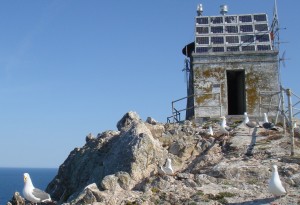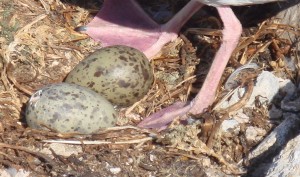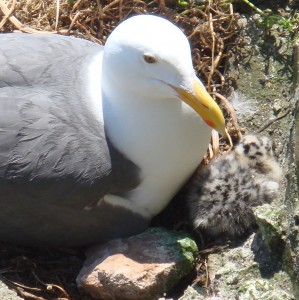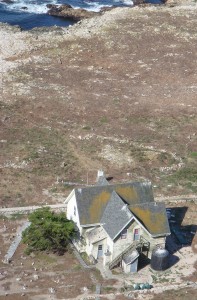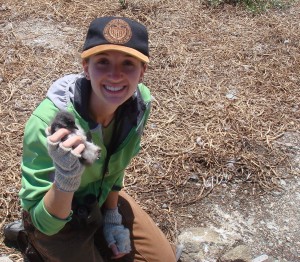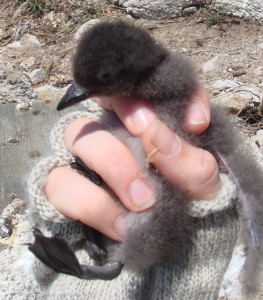Today found me beginning some of my duties, being trained in others, and sometimes simply observing other people. One of Jordan’s responsibilities while she is here will be to conduct the Pelican count every morning, before 9am, from the lighthouse. This can be very difficult–the highest number of Brown Pelicans ever recorded on the island tops 6000, and yesterday, Russ counted about 2500. Since I didn’t have any morning duties today, I went up to the lighthouse with Russ and Jordan, and watched her learn to use the scope. Then, I had about an hour and a half to just stand up at the lighthouse and do whatever I wanted, and it was so amazing.
Visibility today was more than fifty miles, and we could see all the way to Bodega Head, even beyond Point Reyes. I could see the Golden Gate Bridge without binoculars. And, while I was up at the lighthouse, the biggest pod of Risso’s dolphins Russ has ever seen (we estimate about 300) arrived and parked itself in Mirounga Bay, on the West side of the island. The whole time I watched them, they remained, enjoying themselves, and performing complex acrobatics. I also spotted all three of the resident gray whales, watching one of them mosey around the shallows in Fisherman’s Bay for quite some time.
In addition, time at the lighthouse allowed me to observe some of the gulls up there, whose chicks have already begun to hatch.
One gull I found was sitting on an egg which was pipping, meaning its chick was using its egg tooth to begin to crack through the shell:
Other gulls near the lighthouse have already begun to have chicks, and gull chicks are some of the cutest animals on the planet, hands down:
From the lighthouse, you can see everything. A few boats came and went–a sailboat, one fishing boat, and a whale-watching boat. You can see all the foundations of old buildings on the island, and one can do a 360 around the lighthouse to see all of the various islets, gulches, and bays that fringe the island. Finally, you get a great view of our house! Here’s a photo, and the two windows you can see in the upper story (near the staircase) look into me and Jordan’s room:
After the time up at the lighthouse, everyone reconvened at the house to concoct Sunday brunch–a tradition whenever the Sunday schedule allows. Everyone chipped in a dish, and it was delicious. Claudia made bacon; I made scrambled eggs with onions, peppers, and cheese; Pete made waffles; Annie made blackberry sauce for the waffles; Russ made smoothies; and Jordan made some fruit salad.
Following brunch, we all headed out to do a survey of the Cassin’s Auklet chicks on the island, or at least those born to parents of known age. This particular study requires that we weigh the chicks and assess their plumage every five days. The Auklets live, for the most part, in manmade boxes around the island, which allow us easy access to the birds inside.
Auklet chicks are seriously cute animals. By this time of year, many of them are well on their way to having adult plumage. However, some of them are a little behind the rest, and still retain their down, and they weigh only about 50 grams.
This was one of the smaller chicks I pulled out, and he still, almost exclusively, is covered in down. Very soft.
We finished up with the auklet chicks in about an hour, and then I headed to the Sea Lion Cove Blind with Annie to learn how to record re-sightings of Brandt’s cormorants. It’s not a very complicated process, but it can be frustrating, because to read all of the numbers and letters on the band on the leg of a bird who is fifty yards away, you need patience and a really good scope. Sometimes, you can spend fifteen minutes waiting for a bird to shift slightly so you can read the final digit. However, this work is very important, since normally by this time of year, the Cormorants would have nests, eggs, and even some chicks. However, this year, only a handful of nests can be found, and no eggs. The cormorants, who have historically done well here, also had a poor breeding year last year, leading to some concern about their well-being.
I spent more than two hours in the blind, and just got back from that. Annie is cooking dinner right now, and it smells great.
One final unusual sighting, for anyone who likes birds, was that of a Brant Goose, named Molly. Molly’s flock arrived on the island a couple of weeks ago and were picked off one by one. Molly has been attacked by Peregrine Falcons three separate times, and has a limp. However, she is surviving, and I spotted her today, limping around amidst the gulls.
Well, that’s all for today!
Best,
Eleanor

